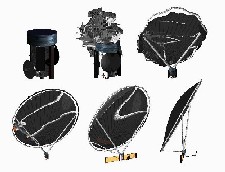How Inflatable Spacecraft Will Work

As the space industry continues to cut costs by using lightweight materials and alternative types of energy, it is opening up the possibility that you and I may one day have the opportunity to live in space. The idea of a colony on the moon or Mars might be made possible with new spacecraft technologies being developed today. One of the remaining barriers to affordable space travel or even placing spacecraft in orbit is still the high price of launching these spacecraft. At today’s prices, it would cost $12,500 just to launch an object as light as an inflated basketball (1.25 pounds) into space. The heavier the spacecraft, the more rocket fuel is needed to get the vehicle off the ground.
NASA and other space agencies are working on constructing a new breed of inflatable spacecraft made of lightweight materials. The amazing thing about these inflatable spacecraft is that they can be squeezed into small canisters only a fraction of their full size and then inflated once they arrive in space using a sophisticated deployment system that releases an inert gas to push out the walls of the inflatable material.
Space inflatable technology has been around since the 1960s, but has played a minor role in space exploration to this point. With the ability to cut costs, space inflatables could once again be used to build 1,000-foot antennas, space habitats or solar sails, which wouldn’t be practical with conventional spacecraft materials. In this edition of How Stuff Will Work, we will take a look at two kinds of space inflatables being developed and how they may pave the way for interstellar travel and Martian colonies.
Since it was put into orbit in April 1990, the Hubble Space Telescope has been the primary tool for gathering images in space. But just getting the Hubble into orbit was a major accomplishment for NASA. Hubble is 43.3 feet (13 meters) long and 14 feet (4 meters) wide, and it weighs about 25,500 pounds (11,000 kg). It would cost more that $25 million to put that type of structure into space today, and that’s not counting the costs for materials to build another Hubble. Yet, to extend our view into space, scientists must be able to place an even more powerful telescope in Earth orbit.
NASA scientists are now using inflatable technology to build a telescope that is nearly twice as large as Hubble but that weighs only about one-sixth as much as Hubble. The 82-foot Advanced Radio Interferometry between Space and Earth (ARISE) will also dwarf Hubble in how far it can see into space. According to early estimates, ARISE will have a resolution 3,000 times better than Hubble. Interferometry is a process by which more than one antenna is used to construct highly detailed photos. In this case, ARISE will be used to take pictures of black holes, interstellar planets and other stars.
Despite ARISE’s much larger size, it is expected to be quite easy to transport into space. The ARISE telescope’s reflector, or antenna, and poles will be constructed out of an advanced thin-film polymer material that can be folded up and stuffed into a small canister, which is then placed on top of the main spacecraft. The reflector itself will be woven into a mesh netting. The canister that holds the reflector is just 1.31 feet (.4 m) tall with a diameter of 5.9 feet (1.8 m). This page shows a good illustration of how the canister is stacked on the spacecraft carrying the ARISE telescope.
The ARISE spacecraft will likely be launched into space onboard a smaller spacecraft than is available today. When the ARISE spacecraft reaches orbit, the mesh netting antenna is released, but it is not this part of ARISE that actually inflates. Instead the three poles, or booms, that connect an inflatable ring around the netting to the spacecraft will inflate. To inflate the poles and the inflatable ring, the Sun’s energy is focused on a heat exchanger containing liquid hydrogen on the spacecraft. This heat allows gas to form, which then flows into the poles and ring. Once the poles are rigid, the antenna will also remain rigid. The entire inflating process will take place in just minutes.
Solar sails, such as this one, may also use inflatable technology. As you can see, solar sails are very similar in construction to the ARISE telescope.
Solar sails, such as this one, may also use inflatable technology. As you can see, solar sails are very similar in construction to the ARISE telescope.
PHOTO COURTESY NASA
In 1996, the Space Shuttle Endeavor deployed an experimental antenna prototype to test this new technology. This 46-foot (14 meter) prototype was successfully inflated over several hours, and generated a great deal of interest in the further development of inflatable spacecraft. NASA has said that the ARISE telescope is scheduled for launch in 2008.
The same technology being used to develop the ARISE telescope could one day be used to construct solar sails that could propel spacecraft beyond the edges of our solar system at incredible speeds. Solar sails will unfurl in space using the same process that inflates the ARISE’s poles and inflatable ring. The sail is actually an ultrathin mirror made of carbon fibers that can capture the sun’s energy to propel an attached spacecraft to speeds up to 200,000 mph (324,000 kph).
The use of space inflatables won’t be limited to unmanned spacecraft and telescopes. NASA has a much more ambitious plan to build inflatable space habitats. The first of these inflatable space habitats, called TransHab, is already in development and could become the living quarters for the International Space Station (ISS) as soon as 2005.
The three-story inflatable will be blown up possibly using nitrogen gas that would fill the spacecraft with several blasts of air. TransHab has been tested to blow up in about 10 minutes once it docks with the ISS, and it should easily stay inflated in the vacuum of space for the life of the craft.
You might picture TransHab as a large balloon connected to the space station. And you might think that it would be susceptible to projectiles in space, such as small asteroids. In fact, tiny meteorites flying through space can travel at speeds seven times as fast as a bullet. Engineers building TransHab have taken this threat into consideration in building the space station residence.
TransHab’s skin has been made of materials that allow it to deflect such projectiles. The one-foot-thick shell is composed of 12 different layers that are designed to break tiny particles of space debris that might hit the shell. The outer shell is made of a Kevlar webbing rated to withstand 12,500 pounds. The layers underneath are made out of Nextel, a ceramic fabric. These layers also protect the occupants from temperatures from 250 degrees Fahrenheit to minus 200 degrees Fahrenheit. Take a closer look at the layers of the TransHab on this page.
At launch, TransHab will have a diameter of 14 feet (4.3 meters), but once it is inflated it will have a diameter of 27 feet (8.2 m), and have a volume of 12,000 cubic feet (339.8 cubic meters). The interior of the 23-foot tall inflated space module will be divided into three floors. The galley and dining table will be located on the first floor. Six sleeping compartments (81 cubic feet per compartment) will be located on the second floor. Each compartment will contain a personal storage area and a computer entertainment center for recreation and personal work. And on the third floor, space station residents will find an exercise space, medical areas and bathrooms.
If humans are to ever go to Mars or set up temporary residence on the moon, we will need to develop closed habitats like the TransHab. Inflatables would be ideal for lunar and Martian colonies because they are compact enough for colonists to take with them.



 Creators of mankind
Creators of mankind Description of “Tall white aliens”
Description of “Tall white aliens” Where they came from?
Where they came from? About hostile civilizations
About hostile civilizations The war for the Earth
The war for the Earth “Tall white aliens” about eternal life
“Tall white aliens” about eternal life Video: “Nordic aliens”
Video: “Nordic aliens” Aliens
Aliens Alien encounters
Alien encounters The aliens base
The aliens base UFO
UFO Technology UFO
Technology UFO Underground civilization
Underground civilization Ancient alien artifacts
Ancient alien artifacts Military and UFO
Military and UFO Mysteries and hypotheses
Mysteries and hypotheses Scientific facts
Scientific facts


















